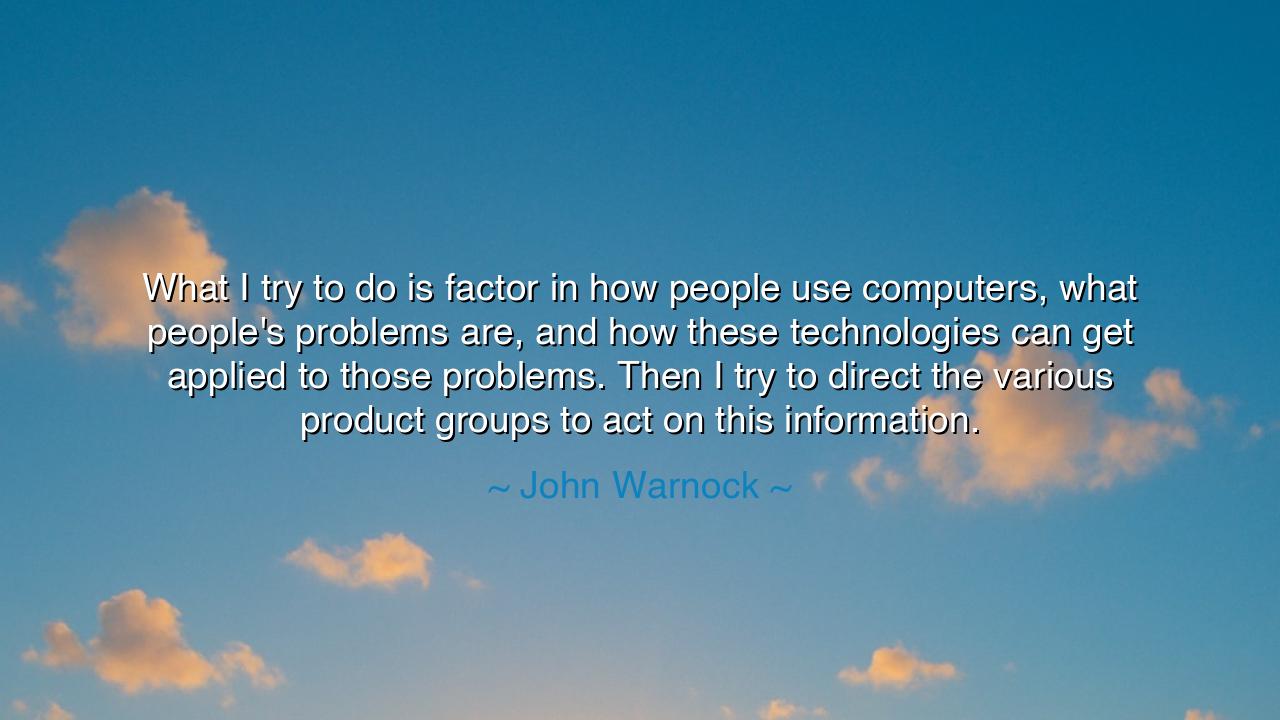
What I try to do is factor in how people use computers, what
What I try to do is factor in how people use computers, what people's problems are, and how these technologies can get applied to those problems. Then I try to direct the various product groups to act on this information.






In the pursuit of progress, the true measure of success lies not in the creation of tools or technologies, but in how they serve the human condition. John Warnock, a pioneer in the field of computer science, reflects this truth in his words: "What I try to do is factor in how people use computers, what people's problems are, and how these technologies can get applied to those problems. Then I try to direct the various product groups to act on this information." In these words, Warnock speaks not merely of the process of technological creation, but of the essential purpose behind it—understanding the needs of humanity and shaping the tools of the future to meet those needs. The greatest inventions are born from the connection between innovation and the real struggles faced by the people.
In the time of the ancient Greeks, philosophers like Aristotle and Plato spoke of a similar pursuit—the marriage of reason and action. Aristotle believed that knowledge without application was futile; true wisdom was found not in mere contemplation but in action that addressed the needs of the community. Similarly, Warnock echoes this principle, recognizing that the purpose of technology is not simply to exist, but to be applied in ways that improve the lives of individuals. The ancient world, for all its monumental achievements, was defined by its focus on the human experience, and this remains true in our modern age, where the most successful technological innovations arise from a deep understanding of humanity and its challenges.
Consider the example of the invention of the printing press by Johannes Gutenberg in the 15th century. Before its creation, the written word was a rarity, reserved for the elite and those in positions of power. Gutenberg’s press, however, revolutionized the way information could be disseminated, making knowledge accessible to the masses. But Gutenberg’s genius was not merely in creating a machine that could print; it was in recognizing that the spread of knowledge would answer the problems of ignorance and inequality in society. Like Warnock, he understood that technology must serve a greater purpose, and that its value lies in its ability to address human needs and to solve the problems of the time.
Warnock’s insight speaks to the essence of true innovation—not simply to build for the sake of building, but to solve real-world issues. It is easy, in an age of rapid technological advancement, to become enamored with the potential of the tools we create. Yet, as Warnock wisely points out, the true success of any product lies in how it improves the lives of its users. In this, we are reminded of the Stoic philosophers, who believed that the highest good was found in acting according to virtue and for the benefit of society. For the Stoics, to be a true philosopher was not to retreat into abstract thought, but to engage with the world, shaping it for the betterment of others.
Consider the example of Steve Jobs, the visionary behind Apple, whose products have touched billions of lives. Jobs, much like Warnock, was not merely interested in creating new technologies; he was focused on how those technologies could address the problems people faced in their daily lives. The iPhone, for instance, revolutionized communication and access to information, yet its true genius lay not in the technology itself, but in its ability to address the fundamental human desire for connection and convenience. Like Warnock, Jobs understood that to create lasting change, technology must be grounded in the human experience, responding to the real needs of society.
The lesson from Warnock’s words is one of deep empathy and awareness. It is not enough to create for creation’s sake. We must always anchor our innovations in the needs and struggles of humanity. This does not mean that we must have all the answers before we begin, but that we must remain grounded in the human experience, never losing sight of the end goal: to create technologies that serve rather than alienate. Just as the great philosophers of the past sought to understand the world not just through intellectual exercise but through meaningful action, so too must we engage with the problems of today in a way that addresses the root causes.
In practical terms, this means that as we face the ever-expanding world of technology, we must approach it with the mindset of a problem solver, constantly asking ourselves: "How does this help others?" "What problem does this solve?" We must be intentional about the ways in which our creations will impact the lives of others, understanding that the true value of any technology is measured not by its complexity or innovation but by its usefulness to society.
Finally, let us remember the timeless wisdom of Warnock: that technology is not an end in itself, but a means to an end. The tools we create must be shaped by the needs of the people they are meant to serve. Whether in the creation of software, hardware, or any other tool, let us always remember that the true measure of success is not in the tool itself, but in how it makes life better for everyone. In this way, we carry forward the ancient teachings that wisdom is not in knowledge alone, but in its application for the good of humanity.






AAdministratorAdministrator
Welcome, honored guests. Please leave a comment, we will respond soon